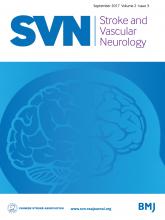Jump to comment:
- 24 September 2017
- 24 September 2017
- 24 September 2017RE: RE: The efficacy and safety of endovascular recanalization of occluded large cerebral arteries during the subacute phase of cerebral infarction: a case series report
By Shugui Shi, MD & Kangning Chen, MD.
To the Reader,
We have reviewed your comments on our paper. For your opinion on the issue of penumbra not to be present in subacute phase of stroke, there are literature reporting its presence days after the initial stroke. Penumbra is a dynamic phenomenon without clear demarcation. For example, there is a zone of benign misery perfusion outside of penumbra with its CBF between 15 to 30ml/100g/min (1). This zone may not be viable if perfusion is not re-established. That is to say with a major cerebral arterial occlusion, even with the help of collaterals, brain tissue may die slowly over a period of time. In clinical practice and proven by imaging studies, the side of brain with a large arterial occlusion will significantly atrophy, a process perhaps related to cell apoptosis from chronic hypoxic state (2). Hence, re-opening the occluded artery may or may not help the immediate stroke, but likely help the large ipsilateral brain tissue in a long run. More longitudinal study is certainly needed to examine this issue.
You have questioned our equipment on its ability to detect penumbra. We have had over 10 years of experience in performing MR perfusion with MRI scanner manufactured by Siemens.
All of our patients have received guideline recommended best medical management including dual antiplatelet and statin therapy plus life style modificat...
Show MoreConflict of Interest:
None declared. - 24 September 2017RE: The efficacy and safety of endovascular recanalization of occluded large cerebral arteries during the subacute phase of cerebral infarction: a case series report
The article by Dr. Chen and his colleagues1 raises an important issue of managing intracranial stenosis or occlusion during the subacute phase of ischemic stroke. The authors concluded that selective percutaneous transluminal angioplasty (PTA) or percutaneous transluminal angioplasty and stenting (PTAS) for intracranial severe stenosis or occlusion is safe and effective in patients with subacute or subacute/chronic stroke. It should be extremely precaution while applying this conclusion into clinical practice. A couple of concerns need to be addressed: (1) there is large body of evidences and publications demonstrated that the ischemic penumbra can exist for only few hours 2. The authors provided the perfusion study in case 1 and commended that there is large area of low perfusion which might be salvageable. However, the authors did not mention which vendor and software have been utilized in the perfusion study. A different vendor and/or software can have significant variability on the result of cerebral perfusion study. I doubt the penumbra (aka, the mismatch on a perfusion study) can last for days in patients with ischemic stroke. (2) American Heart Association/American Stroke Association recommended3 aggressive medical management including dual antiplatelets of aspirin and clopidogrel as well as high-intensity Statin (Class IIB; level of Evidence B) for patients with ischemic stroke caused by 50% to 99% stenosis of a major intracranial artery. Intracranial artery angiop...
Show MoreConflict of Interest:
None declared.






